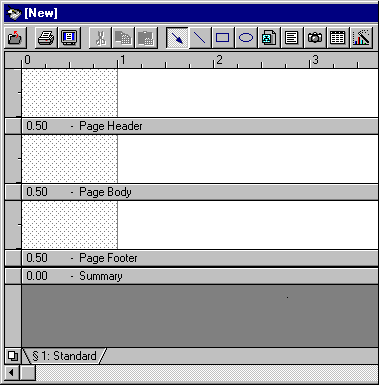|
<< Click to Display Table of Contents >> Bands |
  
|
|
<< Click to Display Table of Contents >> Bands |
  
|
Bands are how you tell ReportPro where to print report objects. ReportPro supports seven types of bands: Background, Page Header, Group Header, Page Body, Group Footer, Page Footer and Summary. Each section that you define in your report will have its own set of bands. Some sections support all band types while others, like the Title Section, only support the Page Body and Background bands.

The Background, Page Header, Page Body, Page Footer and Summary bands are created automatically each time you create a new section. The Group Header and Footer bands are created when you define a grouping.
Background Band
The Background band prints on each page of a report and is always the same size as the printable paper area (paper height - top margin - bottom margin). Objects on the Background band print behind objects in other band types.
Only sections that have Page Header and Page Footer bands support Background bands. During printing, sections that do not have Page Header and Page Footer bands inherit the Background band from the most recently printed section that has a Background band.
To access the Background band, press the Background mode button on the lower left corner of the work window. This button toggles the work window display between the foreground and background modes.
Page Header Band
The Page Header band is used to print objects at the top of each page of the report. The Page Header band prints just below the top margin of the report. This is a convenient location to place the report title as well as the page number and date.
Group Header Band
This band is printed when a report grouping starts. The grouping must contain data or the header will not print. This feature prevents a Group Header / Group Footer combination from printing unless a Page Body band prints.
Group Header bands useful for placing sub-title information. For example if you were creating an invoice listing report that was sorted and grouped by customer, you would probably want to place the customer name in the Group Header band so you could easily identify who the invoices belonged to.
If you create a report that has multiple levels of grouping you'll get a Group Header / Group Footer band combination for each grouping you defined.
Page Body Band
This band is printed for each record in the data source that satisfies the data source's filter criteria. The Page Body band is where you place the report objects that print the body of the report. For example if you were creating a customer listing report, you might place field objects to print the customer name and mailing address in this band.
Group Footer Band
This band is printed after a grouping ends. It is useful for printing totals based on information in the grouping.
Page Footer Band
The Page Footer band is used to print objects that appear at the bottom of each page of the report. The Page Footer band prints the height of the band above the bottom margin. For example, if the bottom margin is one inch and the band height is ½ inch, the band would start printing 1½ inches from the bottom of the page. The Page Footer band is a convenient location to place your company name and report page number.
Summary Band
The Summary band prints after all data associated with its section has been printed. It prints after the Page Body and Group Footer bands but before the last Page Footer band. The Summary band is designed to allow you to print totals and summary information for the data in the data source.